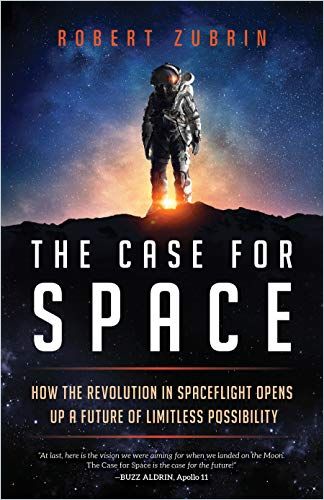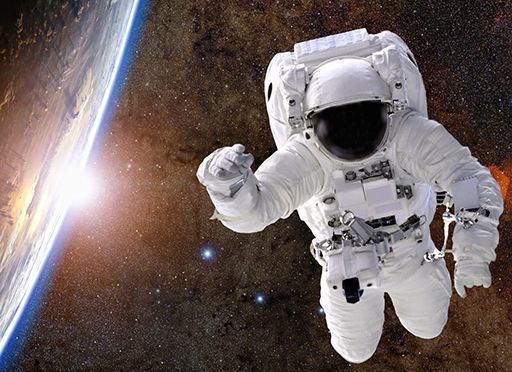Robert Zubrin, author of Mars Direct, provides heartfelt boosterism for space exploration and exploitation.

Space Is the Place
In early 2018, Elon Musk’s rocket – the SpaceX Falcon Heavy – launched into orbit. Over half the rocket is reusable – a transformative innovation that launched a market-driven space race. SpaceX completed the Falcon in record time at relatively low cost. Aerospace engineer Robert Zubrin, author of Mars Direct, argues that it made moon voyages and trips to Mars technically and economically feasible. With market forces rendering space technologies less expensive, tourism in space, exploiting space’s resources and even colonizing space, Zubrin enthusiastically writes, are now conceivable.
Spaceflight
Elon Musk’s SpaceX Falcon Heavy rocket was capable of carrying more than 50 tons into orbit, and its boosters could return to land for refueling and reuse.
This is a revolution. The moon is now within reach. Mars is now within reach.Robert Zubrin
Falcon Heavy opens up the possibility of a lunar base. From low Earth orbit, two rocket-propelled cargo landers, with oxygen and hydrogen as fuel, could go to an appropriate base location. The initial cargo lander could bring in power and communications equipment, vehicles and remotely operated robots. The next cargo lander would bring housing and food for the crew. A Falcon rocket would vault the crew into low Earth orbit, and other craft would deliver them to the moon.
Colonize Mars
Mars possesses the resources to sustain life and advance human society’s evolution. It has frozen water in the ground, accessible carbon, nitrogen, hydrogen and oxygen, and minerals familiar from Earth. The atmosphere of Mars enables the building of sunlit greenhouses on a massive scale.
Mars can be settled. For our generation and many that will follow, Mars is the New World.
A Mars voyage requires deploying a small craft with provisions in advance. This first craft would deliver rocket boosters, liquid hydrogen and a nuclear reactor. Two years after that successful delivery, a second launch would transport a small crew, food sufficient for three years, and an overland vehicle. Every other year a new crew would venture to Mars and the existing Mars crew would return to Earth.
Mars colonizers must use local materials and innovations that crews develop on their base.
Asteroids
Asteroid fragments litter the Earth, offering insight into asteroid composition, which ranges from metal and iron to stone and carbonaceous materials.
Most of the sensational attention to asteroids has centered primarily on their potential threat to humanity and the rest of the terrestrial biosphere.Robert Zubrin
Asteroids could yield great wealth. An approximately two-billion-ton asteroid would contain more than 100 million tons of iron and 7,500 tons of platinum metals. The iron would be worth $140 billion. The platinum metals would be worth $300 billion. No technically feasible way to mine asteroid metal and get it back to Earth exists. That will change when international law establishes private property rights in space. Legal certainty would incentivize financing space exploration and relevant technological innovation.
The Outer Solar System
The outer solar system includes Jupiter, Saturn, Uranus and Neptune, moons the size of planets, and countless asteroids. Outer solar system exploration began with Galileo in the early 17th century. In the 1970s, exploration advanced via unmanned missions such as Pioneer 10 and 11, and Voyager 1 and Voyager 2. Voyager 2 passed Jupiter, Saturn, Uranus and Neptune, sending back detailed images of the planets and their moons.
Even if human beings effectively address climate change, civilization’s need for energy will vastly outstrip the Earth’s – and even the moon’s – resources within a few hundred years. The atmospheres of outer solar system planets will become humans’ principal energy source. Efficient thermonuclear fusion reactors that process deuterium-helium-3 will generate the energy. Spacecraft fleets will deliver this energy from the outer solar system.
To the Stars
Interstellar travel is space travel’s ultimate fantasy. The nearest stars are dramatically more remote than the planets in the outer solar system. Measured in astronomical units – with one AU equaling 150 million kilometers – Saturn is 9.5 AU from the sun; the nearest stars are 270,000 AU away. At its greatest speed on its 13-year trip to Neptune, the Voyager spacecraft traveled approximately 3.4 AU a year and would have taken thousands of years to reach the nearest stars.
Many people believe interstellar travel is impossible.
Getting to the stars may require only developments in current engineering. For example, chemical rocket systems already exist, and engineers might push that system to get a rocket to the stars in 130,000 years. Nuclear fission has much greater capacity. An ideally functioning nuclear fission system could reach a speed close to 10% of the speed of light, and get to the stars in 54 years. A nuclear fusion system could reach the stars in 43 years.
As humans and advanced human civilization move to other planets and ultimately to the stars, they will transport life to those places.
The Human Future
Space is the most effective site for astronomical observation tools. The Hubble Space Telescope radically transformed understanding of the universe. The even-more-advanced telescopes NASA is developing will examine the cosmos with more precision. Building telescopes on the moon would advance knowledge still further.
We are young, the universe is in its spring, and the door has been opened, inviting us outside to meet the dawn of the greatest adventure ever.Robert Zubrin
Since their origins 200,000 years ago in Africa, human beings – Homo sapiens – have never remained in the same place. Humans voyaged out of Africa and ended up in the often-harsher environments of Europe and Asia, where they created new ways of living and surviving. They innovated out of necessity, and began the human civilization that exists today. Moving beyond Earth will make humans more powerful, knowledgeable and profound. And humans must eventually move to yet another frontier – the stars.
True Believer
Robert Zubrin is a true believer, and his fervent beliefs at times render his breathless enthusiasm less than credible. Skeptical readers will still enjoy his descriptions of the problems humans must conquer to live on the moon and Mars. Zubrin’s philosophical reasoning behind the necessity for space travel is pretty thin, and seems aimed at a junior high audience. He’s less clear on exactly what humans will do on the moon, Mars and asteroids, but argues strenuously for the vast profits to be mined from each.





